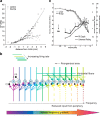Ringing ears: the neuroscience of tinnitus
- PMID: 21068300
- PMCID: PMC3073522
- DOI: 10.1523/JNEUROSCI.4028-10.2010
Ringing ears: the neuroscience of tinnitus
Abstract
Tinnitus is a phantom sound (ringing of the ears) that affects quality of life for millions around the world and is associated in most cases with hearing impairment. This symposium will consider evidence that deafferentation of tonotopically organized central auditory structures leads to increased neuron spontaneous firing rates and neural synchrony in the hearing loss region. This region covers the frequency spectrum of tinnitus sounds, which are optimally suppressed following exposure to band-limited noise covering the same frequencies. Cross-modal compensations in subcortical structures may contribute to tinnitus and its modulation by jaw-clenching and eye movements. Yet many older individuals with impaired hearing do not have tinnitus, possibly because age-related changes in inhibitory circuits are better preserved. A brain network involving limbic and other nonauditory regions is active in tinnitus and may be driven when spectrotemporal information conveyed by the damaged ear does not match that predicted by central auditory processing.
Figures

References
-
- Axelsson A, Ringdahl A. Tinnitus—a study of its prevalence and characteristics. Br J Audiol. 1989;23:53–62. - PubMed
-
- Bauer CA, Brozoski TJ, Holder TM, Caspary DM. Effects of chronic salicylate on GABAergic activity in rat inferior colliculus. Hear Res. 2000;147:175–182. - PubMed
-
- Bauer CA, Brozoski TJ, Myers K. Primary afferent dendrite degeneration as a cause of tinnitus. J Neurosci Res. 2007;85:1489–1498. - PubMed
-
- Berliner KI, Shelton C, Hitselberger WE, Luxford WM. Acoustic tumors: effect of surgical removal on tinnitus. Am J Otol. 1992;13:13–17. - PubMed
Publication types
MeSH terms
Grants and funding
LinkOut - more resources
Full Text Sources
Other Literature Sources
Medical
